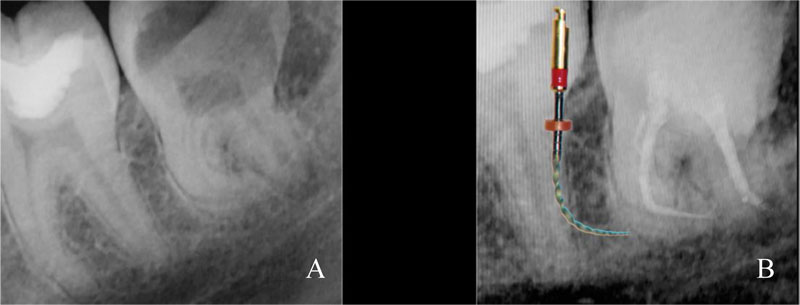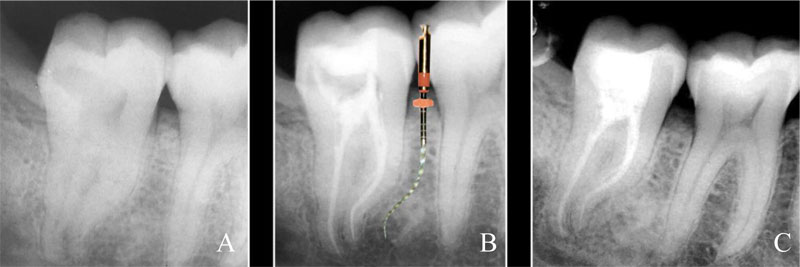All published articles of this journal are available on ScienceDirect.
Management of Severe Curvatures in Root Canal Treatment with the New Generation of Rotating Files Using a Safe and Predictable Protocol
Abstract
Objective:
The aim of this work was to show the management of severe curvatures done with the new generation of rotating files through a safe and predictable protocol.
Methods:
Three clinical cases were described. A safe protocol was explained using the latest generation of rotating files for the shaping of the anatomy of complex root canals. All the cases presented 90°, 45° curvatures and/or double curvatures.
Results:
The instrumentation of canals increased their surface area and volume. All the cases with 90° and 45° curvatures were optimally shaped.
Conclusion:
With the help of rotating files in the martensitic alloy, it is possible to work safely, while avoiding the risk of file separation, even in root canals with severe curvatures, thus achieving success even in complex clinical cases.
1. INTRODUCTION
The goal of modern endodontics is to eliminate or reduce bacterial load inside the endodontic space, which is possible by performing adequate shaping and three-dimensional cleansing followed by filling with thermoplasticized gutta-percha [1-5]. The first phase, the shaping, is carried out using hand stainless-steel files and rotating Ni-Ti files [6, 7]. The clinical introduction of Ni-Ti files presented a turning point in the history of endodontics. Moreover, it allowed the production of new endodontic instruments, both manual and rotating, with better features than stainless steel ones [8]. This invention led to the achievement of more effective and reproducible results. Ni-Ti alloys, used in dentistry, have a rational atomic composition of Ni-Ti, consisting of 55% of Ni and 45% of Ti [9, 10].
In the past, the only available way to improve the performance of Ni-Ti instruments was to change their dimensions, tip, cross-sectional and flutes’ design. With the development of M-wire and Twisted File technology, the instruments have been commercialized to improve safety [11]. Kinetic motion is another important factor.
Ni-Ti instruments were traditionally used with the continuous motion, but in the last years, a reciprocating movement has been introduced [12]. Some authors demonstrated that the reciprocating motion can extend the cyclic fatigue resistance of Ni-Ti instruments when compared to continuous rotation, however, these are only preliminary results [13].
Although the use of Ni-Ti alloy involves a series of advantages, the use of these rotating instruments in endodontics involves a possible and increased risk of fracture compared to the use of stainless steel files [14]. Cyclic fatigue occurs when a metal is subjected to repeated cycles of tension and compression that causes its structure to break down, ultimately leading to fracture. Torsional fatigue is the twisting of metal around its longitudinal axis at one end, while the other end is in a fixed position [15, 16]. The resistance to cyclic fatigue of Ni-Ti rotary instruments can be increased through improvements in the manufacturing process or by the use of new alloys with higher mechanical properties [17-19]. There have been many studies on the cyclic resistance of different Ni-Ti rotary instruments with different designs or compositions [20].
Therefore, the aim of this study was to show root canal treatments with severe curvature using modern Ni-Ti Files.
2. MATERIALS AND METHODS
In the current work, three clinical cases with serious curvatures are discussed which include cases shaped in maximum safety, next to the new rotary files, HyFlex EDM (Coltene/Whaledent, Langenau, Germany).
HyFlex EDM Ni-Ti are instruments with completely new properties due to their innovative production process using electric discharge processing that creates a unique surface of the new Ni-Ti files and makes HyFlex EDM files more resilient and resistant to fractures.
2.1. Selected Cases
In the first case, a 65 years old female patient was presented with pain associated with the third mandibular molar 3.8. After clinical and radiographic examination, the diagnosis was a non-vital tooth associated with symptomatic apical periodontitis. The patient was unfit for extraction due to her medical condition, therefore, root canal treatment was recommended. In the radiograph, it was possible to see a 90° severe curvature in the mesial root.
In the second case, a 35 years old female patient presented with irreversible pulpitis in the second mandibular molar 4.7. The radiograph showed a severe double curvature in the mesial root.
In the third case, a 50 years old male patient presented with pain in the mandibular left side. There was a fixed bridge 6x8; the bridge was removed and the clinical diagnosis confirmed irreversible pulpitis in tooth number 3.8. Radiographic examination showed 45° severe curvatures in the mesial roots and a 90° severe curvature in the distal root.
2.2. Root Canal Preparation Protocol
The protocol for shaping, in a safe and predictable way, with a severe curve was as follows:
Predominantly, it is essential to perform a correct pre-operative radiograph and to assess the presence and degree of curvature present in the tooth to be treated. Obviously, the traditional intraoral radiograph (2D) was used, which can only be useful for detecting curvatures on the Mesio-Distal projection. In the case of a curvature on the Bucco-Palatal direction, this common radiograph is not effective in identifying it; therefore, its existence was detected only through manual scouting.
In case of a severe curvature at 120°, 90° or more, through intraoral radiograph, the distance from the occlusal surface to the beginning of the curvature was calculated and 0.5 - 1 mm was subtracted.
Once the operative field was isolated and a correct access cavity was performed, the orifices were probed in the first mms using a small hand file that was not pre-bent.
2.3. Pre-Flaring
When the pre-flaring of the first mm of the coronal third was performed, during this phase, the HyFlex EDM 25.12 opener (Coltene/Whaledent, Langenau, Germany) was utilized.
2.4. Scouting
At this stage, it was necessary to use a pre-bent 0.08 K-File (Coltene/Whaledent, Langenau, Germany) adjusted with a rubber stopper at the length measured before the curvature.
The scouting took place by applying little pressure with the balanced force motion. In this phase, the file must always be connected to the apex locator. The scouting ended when the 0.08 file reached the point before the curvature.
2.5. Glide-Path
A pre-bent K-File 0.10 (Coltene/Whaledent, Langenau, Germany) was brought to the point before the curvature.
At this point, the glide-path was finished, always at the same point, using HyFlex EDM 10.05(Coltene/Whaledent, Langenau, Germany) designed specifically for the glide-path.
2.6. Shaping
HyFlex EDM 20.05 (Coltene/Whaledent, Langenau, Germany) was used up to the same point before the curvature.
2.7. Scouting
The small pre-curved K-File 0.08 was again inserted beyond the curvature that reached the correct working length as confirmed by the apex locator.
2.8. Glide-Path
A pre-bent 0.10 K-File was brought to the working length.
Following that, a pre-bent K-File 0.15 was delivered 2 mm before the working length.
Then, HyFlex EDM 10.05 was used up to the working length. (This file should be inserted in the canal pre-bent and without rotation. After it reaches beyond the curvature, the rotation should be activated).
2.9. Scouting
Using HyFlex EDM 20.05, the working length was reached (This file should be inserted in the canal pre-bent and without rotation. After it reaches beyond the curvature, the rotation should be activated).
Then, the shaping phase was finalized using EDM 20.05 (Coltene/Whaledent, Langenau, Germany). According to the difficulty of the case, the shaping is continued using the HyFlex EDM 25 One File which has 0.8 taper in the first mm and then the taper decreases (This file should be inserted in the canal pre-bent and without rotation. After it reaches beyond the curvature, the rotation should be activated).
During the glide-path and shaping phase, it was fundamental to exploit the martensitic alloy of these modern rotating files. Both the HyFlex EDM 10.05 and 20.05 and the 25 one file must be pre-curved before being inserted into the root canal. Owing to their modern alloy, this was possible, without causing a risk of fracture of the instrument, and with the help of pre-curving, the rotating file easily passed the curvature regardless of its severity.
All the files, manual or rotating, must always work in the presence of an irrigant and between one file. Additionally, it was necessary to check the patency by a small K-File.
Both manual and rotary files must work within the root canal only for a few mms; the working length should not be reached instantly. Therefore, after every 2-4 mm of work, the files were removed from the root canal to be cleaned. The canal was then irrigated, and shaping was continued.
During scouting, pre-flaring, glide-path and shaping the files must always be carefully observed to note if the flutes are intact or have been damaged due to stress.
Another great advantage of the new rotating files, HyFlex EDM, is that in case of the opening of the flutes due to stress, they can be regenerated using heat, and the files return as new and can be reused without risk.
HyFlex EDM must be used with continuous rotation. HyFlex 10.05 must be used at 300 rpm with a torque of 1.6 N cm. HyFlex EDM 20.05 and 25 one file must be used at 400 rpm with a torque of 3 N cm.
The HyFlex, due to their special alloy, can tolerate severe bends without the risk of fractures and without altering the original anatomy of the root canal.
3. RESULTS
The instrumentation of root canals increased the surface area and volume of all the selected teeth. All the cases with 90°and 45° curvatures were optimally shaped (Figs. 1-3).



4. DISCUSSION
Reviewing the literature, there is still a debate regarding the impact of torsional stress and metal fatigue on the fracturing of Ni-Ti rotary instruments [21]. A number of studies have stated that fatigue is the predominant mechanism in material failure [14]. Different types of rotary files exhibit differences in resistance to fatigue failure due to differences in various determinants, such as their manufacturing process, structural characteristics geometric designs and surface texture [22]. It has been clearly shown that multiple factors contribute to file separation, and cyclic fatigue is one of the leading causes. Fatigue failure usually occurs due to the formation of microcrack at the surface of the file that is caused by surface irregularities [23]. During each loading cycle, microcracks develop, getting deeper into the material until the complete separation of the file [14].
Several studies show that the new rotating files, HyFlex EDM, have excellent characteristics in terms of resistance to cyclic fatigue [11, 14, 22]. Therefore, in endodontic cases with complex anatomies, these modern rotating files can help the clinician to completely shape the root canal up to the working length avoiding fractures at the same time.
CONCLUSION
On the basis of the use of these new rotating files, this clinical work shows how it is possible to safely shape complex root canals with severe curvatures, hence completing difficult clinical cases.
ETHICS APPROVAL AND CONSENT TO PARTICIPATE
The Ethical Committee of University of Salerno, Italy approved the study with Protocol. No. 34/2013.
HUMAN AND ANIMAL RIGHTS
No animals were used in this research. All human research procedures followed were in accordance with the ethical standards of the committee responsible for human experimentation (institutional and national), and with the Helsinki Declaration of 1975, as revised in 2013.
CONSENT FOR PUBLICATION
All patients participated on a voluntary basis and gave their informed consent.
AVAILABILITY OF DATA AND MATERIALS
The authors confirm that the data supporting the findings of this study are available within the article.
FUNDING
None.
CONFLICT OF INTEREST
The authors declare no conflict of interest, financial or otherwise.
ACKNOWLEDGEMENTS
Declared none.


